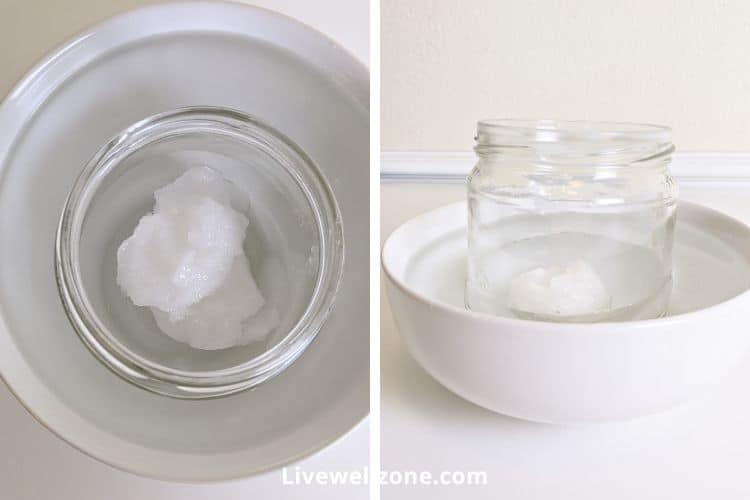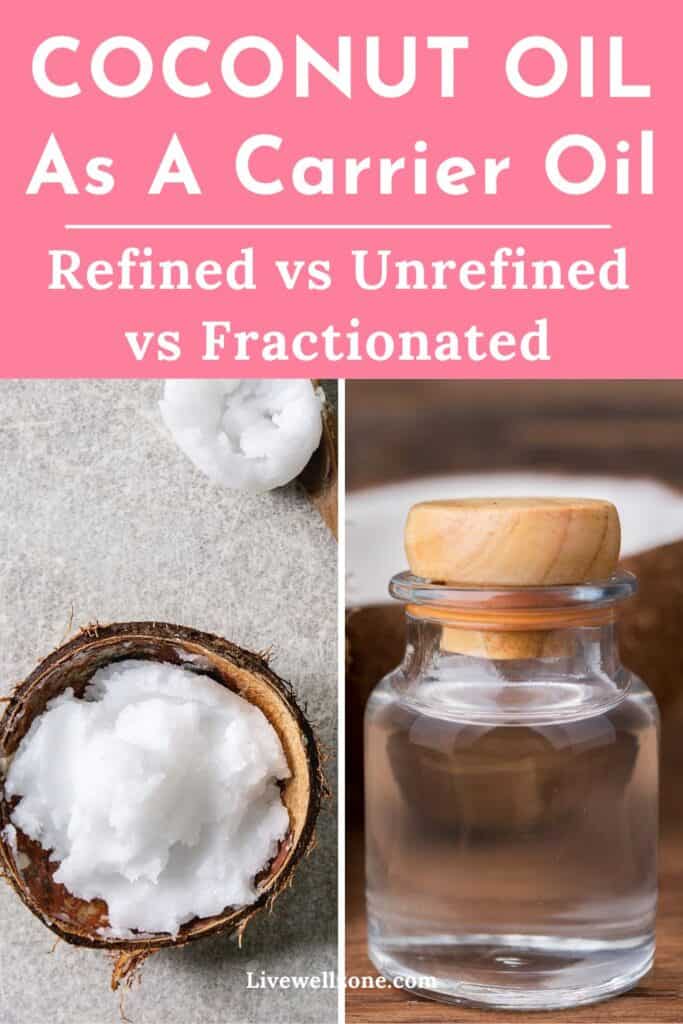
Whether it’s unrefined (virgin), refined or fractionated, there are various types of coconut oil available to use these days. With all of these of choices, you might be wondering what kind of coconut oil is best as a carrier oil. Well, here’s the deal:
Fractionated coconut oil is better for the face because it is lightweight, more easily absorbed and less likely to clog pores. For the rest of the body, other types of coconut oil – be it unrefined, refined or fractionated – can be used, depending on your skincare goals.
Now, one thing to be aware of is that there are some nutritional differences between the different types of coconut oil. These differences can potentially affect the results that you get from each oil.
To help you make sense of all this, this article is going to compare and contrast different kinds of coconut oil so that you understand what they each bring to the table. In addition, we’re also going to discuss how to mix coconut oil with essential oils and how to include it in your skincare routine.
Note: this post contains affiliate links and I earn a commission (at no additional cost to you) if you use them to make a purchase.
UNREFINED VS REFINED VS FRACTIONATED COCONUT OIL AS CARRIER OILS: BENEFITS AND DIFFERENCES
There are several different factors that differentiate the three types of coconut oil. Here’s an overview of each factor.
FATTY ACID COMPOSITION
- The main subcategories of fats in virgin coconut oil are medium chain fatty acids (MCFA) and long chain fatty acids (LCFA).
- Lauric acid is the most abundant fatty acid in virgin coconut oil and it is known for having antimicrobial properties. Depending on which expert you talk to, lauric acid is either a MCFA or a LCFA. Aside from lauric acid, virgin coconut oil has other MCFAs like caprylic and capric acid, which are also antimicrobial (1, 2, 3).
- Refined coconut oil has most of the same nutrients as unrefined. However, some antioxidants and other phytonutrients are lost during the refinement process. So, this may affect the skincare benefits that you get from topical application of refined coconut oil.
- Fractionated coconut oil is the most heavily processed of all the coconut oils. It doesn’t have any long chain fatty acids, nor does it contain lauric acid and other nutrients. Instead, it is composed mainly of MCFAs like capric and caprylic acid.
CONSISTENCY
- Both unrefined and refined coconut oil are solid at room temperature (thanks to the presence of long chain fatty acids).
- On the other hand, fractionated coconut oil is liquid at all temperatures because it has been processed to remove the solid components of coconut oil (such as the long chain fatty acids).
ABSORPTION RATE
- When applied to the skin, both refined and unrefined coconut oil are absorbed slowly. As a result, they can sit on the skin and may clog pores. These types of coconut oil are generally unsuitable for oily or acne-prone skin.
- Fractionated coconut oil is lightweight and penetrates the skin more easily. As a result it’s less likely to clog pores and may be better tolerated by those with oily or acne-prone skin.
SCENT
- Virgin coconut oil has a distinct coconut smell, while unrefined coconut oil is almost odorless.
- On the flip side, fractionated coconut oil has undergone processing that makes it completely odorless.
The table below summarizes the differences between each of these oils.
| Unrefined (Virgin) | Refined | Fractionated |
|---|---|---|
| Coconut scent | Odorless | Odorless |
| Solid at room temperature | Solid at room temperature | Always liquid |
| Contains lauric acid, along with other MCFAs, LCFAs | Contains lauric acid, along with other MCFAs, LCFAs | Contains MCTs and NO lauric acid |
| Slow absorption | Slow absorption | Absorbs easily |
| Can be comedogenic | Can be comedogenic | Less comedogenic |
| Locks in moisture (source) | Locks in moisture | Locks in moisture |
| Considered anti-inflammatory; may help wound healing and atopic dermatitis (eczema) (4, 5) | Some of the same benefits as unrefined, but lacks some of the nutrients in unrefined | May have antioxidant properties thanks to the presence of capric and caprylic acid, which are both antioxidants. |
HOW TO DILUTE ESSENTIAL OILS WITH COCONUT OIL
Step 1: Choose your preferred type of coconut oil

You can mix fractionated, refined or unrefined coconut oil with essential oils.
If you’re using the fractionated kind, you can skip to Step 2 below.
On the other hand, if you’re using refined or unrefined coconut oil and you’re in a cool environment (below 76°F), then your oil will be solid. So, you have to melt it first.
To melt the oil, do one of the following:
- use a double boiler.
- place the coconut oil in a sealed jar, then place the jar in a sink or bowl filled with hot water (as shown below). Let the jar sit in the hot water for a few minutes until the oil is fully liquid.

Step 2: Choose your essential oil dilution level
The essential oil dilution you use will depend on your intended use. Here are the general guidelines (source):
| Daily face cosmetics | up to 1.5% |
| Body massage products | up to 3% |
| Bath products | up to 4% |
| Pain and wounds | 5 – 20% |
Step 3: Add essential oils to the coconut oil
After selecting the dilution level that matches your needs, you can mix the essential oil and coconut oil and essential oil. Here’s a quick reference chart that shows you how much essential oil and coconut oil (CO) to use for different dilutions.
| 15ml CO (1/2 oz, 1 Tbsp) | 30ml CO (1 oz, 2 Tbsp) | 60ml CO (2 oz, 3 Tbsp) | |
| .5% | 2 drops | 4 drops | 9 drops |
| 1% | 4 drops | 9 drops | 18 drops |
| 1.5% | 6 drops | 13 drops | 27 drops |
| 2% | 9 drops | 18 drops | 36 drops |
| 3% | 13 drops | 27 drops | 54 drops |
| 5% | 22 drops | 45 drops | 90 drops |
For more information on essential oils that are safe for the skin and how to dilute them, make sure to read this guide on how to dilute essential oils for the skin.
Last but not least, here are some coconut oil brands that I suggest using for your blends:
- For unrefined coconut oil you could use what you already have in your kitchen. Personally, I love this jumbo sized coconut oil form Kirkland Signature. I’ve been using it for the past 6 years and it’s never failed me! However, if you want something smaller, that is made by a skincare brand, then go with this organic, virgin coconut oil from Sky Organics.
- If you’re curious about refined coconut oil, Nutiva makes this food grade oil that’s very reliable.
- When it comes to fractionated oil, here’s a good, unscented one from Sky Organics.
FAQs ABOUT USING COCONUT OIL AS A CARRIER
What can I add to coconut oil to make it smell better?
Essential oils can help to mask the smell of unrefined coconut oil. But keep in mind that essential oils are medicinal and ideally, they should be used for their therapeutic benefits (not simply as perfume). Here are some skin-friendly oils to consider:
- vanilla.
- rose.
- sandalwood.
- cedarwood.
- citrus oils (such as bergamot, key lime and sweet orange)
- geranium.
- patchouli.
- lavender.
- peppermint.
In addition, if you’re a fan of the chocolate scent, then making a body butter blend that combines coconut and unrefined cocoa butter is a fantastic way of covering up the coconut scent.
How do you use coconut oil as a carrier oil?
When adding coconut oil to your beauty routine, you can use it as a:
- makeup remover.
- cleansing oil.
- daily face oil.
- base for body butters, salves, lotions and creams.
- sealant for hair, or a deep conditioner.
CONCLUSION
If you’re looking to get the full spectrum of anti-inflammatory, antimicrobial and moisture-locking benefits that coconut oil has to offer, then you definitely want to reach for the unrefined kind. However, if you’re worried about coconut oil’s potential comedogenic effects – and you don’t mind losing out on some of the nutrients – then the fractionated variety is your best bet.

You Might Also Enjoy:
Non-Greasy Carrier Oils For Skin: 10 Oils To Fall In Love With
Best Oils for Acne Prone Skin: Carrier, Essential and Cleansing Oils You Shouldn’t Ignore
How to Make Stretch Mark Cream and Oil: Step-by-Step Guide
Best Carrier Oils for Sensitive Skin: 10 Oils To Soothe Dryness, Acne, Cracked Skin & More
Rosehip Oil vs Jojoba Oil for Face (And Body): Which is Better and How To Use
What To Mix (And Not) With Rosehip Oil For Face – The Ultimate Guide
The Difference Between Rosehip Oil and Rosehip Seed Oil: Benefits, Which To Use and How to Use
What To Mix With Shea Butter for Skin and Hair: Tips and Recipes

